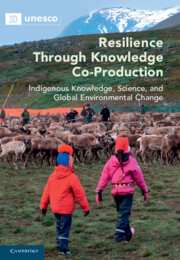 Resilience through Knowledge Co-Production
Resilience through Knowledge Co-Production from Part I - From Practice to Principles
Published online by Cambridge University Press: 02 June 2022
The Iñupiat Eskimo on Alaska’s North Slope live semi-traditional lives characterized by subsistence hunting and fishing and expansive natural travel networks. To the Iñupiat, the North Slope coastline is a social-cultural boundary between sea and land, marked by the location of past and current settlements, burial sites, family hunting locations, traditional places of refuge, and places immortalized through traditional stories. The coastline is where they observe, enter and exit the marine environment, and hence is interwoven throughout their local and traditional knowledge of the ocean and sea ice environment. Rarely, do local experts speak of ocean or ice features, or of a hunting story, without referring to a place on land. North Slope communities and their coastline are also staging areas for scientists who have adopted the Chukchi and Beaufort Seas as their natural laboratories. This chapter will explore a cross-section of the North Slope’s rich history of scientists working with local indigenous experts on coastal and marine topics, with specific attention to coastal emergency preparedness.
To save this book to your Kindle, first ensure no-reply@cambridge.org is added to your Approved Personal Document E-mail List under your Personal Document Settings on the Manage Your Content and Devices page of your Amazon account. Then enter the ‘name’ part of your Kindle email address below. Find out more about saving to your Kindle.
Note you can select to save to either the @free.kindle.com or @kindle.com variations. ‘@free.kindle.com’ emails are free but can only be saved to your device when it is connected to wi-fi. ‘@kindle.com’ emails can be delivered even when you are not connected to wi-fi, but note that service fees apply.
Find out more about the Kindle Personal Document Service.
To save content items to your account, please confirm that you agree to abide by our usage policies. If this is the first time you use this feature, you will be asked to authorise Cambridge Core to connect with your account. Find out more about saving content to Dropbox.
To save content items to your account, please confirm that you agree to abide by our usage policies. If this is the first time you use this feature, you will be asked to authorise Cambridge Core to connect with your account. Find out more about saving content to Google Drive.